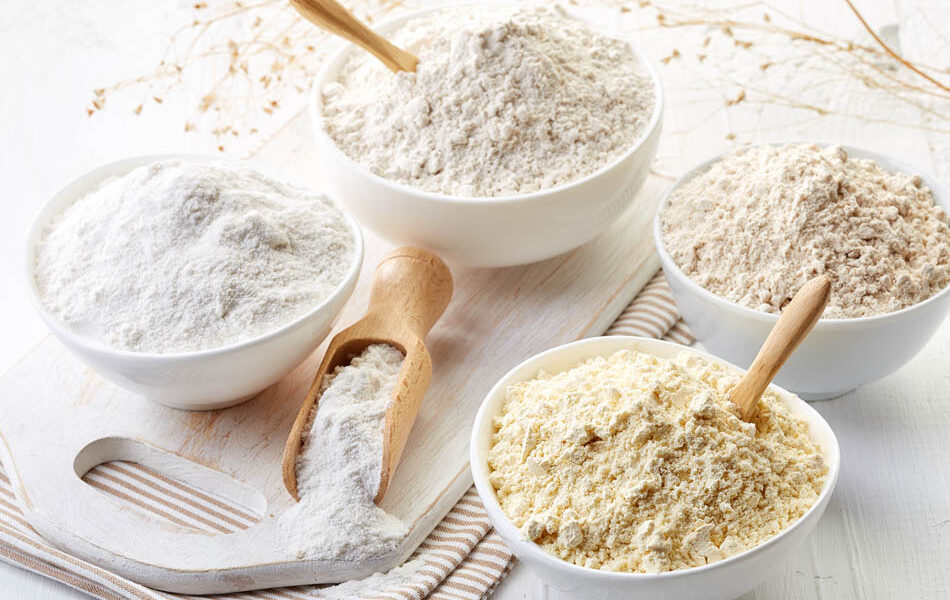7 Best Flour Options for Managing Diabetes: A Review
If you have diabetes, low-carb recipes can be the way to incorporate pastries, cookies, and desserts into your lifestyle without affecting your blood sugar. Here, we’ll go over the 7 best flour options for someone with diabetes.

Having diabetes doesn’t mean you need to avoid pastries, cookies, and desserts. However, it does mean you need to make some replacements to make them more suitable to avoid spiking blood sugar levels.
You can make several modifications to make it more friendly for someone with diabetes.
One of the ways you can modify a recipe is to switch from white flour, which has a high glycemic index, to flour with a lower glycemic index and carb content.
Fortunately, there are 7 different flour options to use if you want to avoid your sugar levels from spiking.
Here, our experts will analyze all the best options that are better than wheat flour.
7 Best Flour Choices for Diabetes: A Comprehensive Guide
The following options are the best flours for someone with diabetes. They have a lower glycemic index (GI) compared to wheat flour, and some aren’t high in carbs.
With that said, others are better off consuming in moderation since they’re still a source of carbs. Even though they have a lower glycemic index, you still need to control how many carbs you eat throughout the day to avoid any spikes.
Here are the 7 best low-GI flours to consume if you have diabetes.
#1 Almond flour
Almond flour is one of the best options to include if you have diabetes.
One of the biggest benefits of almond flour is its low glycemic index. Almond flour has a glycemic index of less than 1, meaning it will have a very low impact on blood sugar levels.
If you are wondering how many grams of carbs almond flour has, here is the nutritional value per 100g:
- Calories: 622
- Total Carbs: 16.2g
- Fiber: 9.3g
- Net carbs: 6.9g
- Protein: 26.2g
- Fats: 50.2g
As you can see, almond flour is a very low-carb flour, making it an ideal option for someone with diabetes.
Almond flour has a nutty flavor and can be exchanged on a 1:1 ratio with wheat flour. This means that if the recipe calls for 1 cup of wheat flour, you can use 1 cup of almond flour.
Since almond flour is finely ground almonds, it is better to replace conventional wheat flour. On the other hand, since it is slightly coarser, almond flour is better for breading or cooking.
If you don’t like almond flour, you can replace it with walnut flour, which has a similar nutritional value.
#2 Oat flour
Another great option is oat flour.
Oat flour has a glycemic index of 44, making it a low-GI food. Thanks to its low GI, it won’t have a massive effect on blood sugar levels. You can make oat flour by grinding oatmeal until you get a fine powder.
The nutritional information for 100g of oat flour is as follows:
- Calories: 339
- Total Carbs: 69.9g
- Fiber: 10.5g
- Net carbs: 59.4g
- Protein: 13.2g
- Fats: 6.3g
One of the benefits of oatmeal is its high fiber content which can help regulate blood sugar levels and reduce cholesterol levels.
Still, you need to be careful about how much you eat since it is not a carb-free option.
When substituting for regular flour, you might need to add more. So, for every cup of regular flour, you should use 1 and one-third of a cup of oat flour.
#3 Chickpea flour
Chickpea flour or garbanzo bean flour is another option with a very low GI. Chickpeas have a glycemic index of 6, making them an excellent option to prevent your blood sugar from spiking.
The following nutritional information is for 100g of chickpea flour:
- Calories: 387
- Total Carbs: 57.8g
- Fiber: 10.8g
- Net carbs: 47g
- Protein: 22.4g
- Fats: 6.7g
Chickpea flour stands out because of its high protein content, which can help control blood sugar levels and reduce insulin resistance.
This flour offers a nutty flavor that pairs with savory and sweet dishes.
If you are replacing regular flour with chickpea flour, you will need to cut it in half. For example, if the recipe calls for 1 cup of flour, add half a cup of chickpea flour.
#4 Soy flour
Made by grinding soybeans into a fine powder, soy flour is another excellent choice to help control blood sugar levels since it has a glycemic index of 5.
Here is the nutritional information for 100g of soy flour:
- Calories: 439
- Total Carbs: 30.4g
- Fiber: 20.7g
- Net carbs: 30.4g
- Protein: 38.1g
- Fats: 21.9g
Soy flour is an excellent option for people on a low-carb diet with a high-protein intake.
So, if you have diabetes and want to follow a more plant-based approach, soy flour can be an excellent choice to help you reach your protein requirements. Remember that protein is essential for muscle support, controlling blood sugar levels, and providing satiety.
One way you can use this option, besides baking goods, is as a thickening agent for your sauces.
#5 Coconut flour
Coconut flour is another viable option made from ground coconut meat until you get a fine powder.
It has a low glycemic index of 43, meaning it won’t spike your blood sugar levels a lot.
Coconut flour has the following nutritional value per 100g:
- Calories: 400
- Total Carbs: 60.0g
- Fiber: 33.3g
- Net carbs: 26.7g
- Protein: 13.3g
- Fats: 13.3g
One of the advantages of coconut flour is that it is very high in fiber, allowing for better glucose management, and it is also very low in carbs.
It offers a sweet flavor, which you can use in savory and sweet dishes.
However, one thing to keep in mind is that coconut flour absorbs a lot of water. So, for every cup of regular flour, you only need to use one-fourth of a cup of coconut flour. Additionally, make sure to add more liquid.
For example, if you use one-fourth of a cup of coconut flour, you need to add one-fourth of a cup of the liquid you choose to mix. Otherwise, the recipe might end up being too dry.
#6 Spelt flour
Spelt flour is another option you can use instead of regular flour. However, spelt flour has a glycemic index of 55–60, meaning it has a medium impact on blood sugar. For that reason, you might want to consume it in moderation.
Here is the nutritional information for 100g of spelt flour:
- Calories: 364
- Total Carbs: 70.7g
- Fiber: 9.3g
- Net carbs: 61.4g
- Protein: 14.5g
- Fats: 2.5g
Spelt flour has a nutty flavor that you can use in cookies, pastries, or bread.
However, since it is high in carbs, you might want to consume it in moderation to avoid creating a blood sugar spike.
With that said, you can always mix it with another flour. For example, you can combine spelt flour with buckwheat flour to create a low-carb bread option.
You can substitute regular flour on a 1:1 ratio. For example, if you use 1 cup of regular flour, you can use 1 cup of spelt flour.
#7 Millet flour
Finally, millet flour is another option worth including if you have diabetes.
Millet flour has a glycemic index of 52, meaning it has a low effect on blood sugar.
The following information is for 100g of millet flour:
- Calories: 382
- Total Carbs: 75.1g
- Fiber: 3.5g
- Net carbs: 71.6g
- Protein: 10.8g
- Fats: 4.2g
Research shows that consuming millet might have positive effects in controlling blood sugar levels.
However, millet flour is a flour with low fiber content and high carb content. Therefore, it is best to consume it in moderation.
Is Flour Bad for Those With Diabetes?
No, flour is not bad for people with diabetes. However, it depends on the type of flour you choose. Simple carbs like wheat flour and white rice flour are not the best options since they have a high glycemic index, which spikes your blood sugar levels.
However, options like almond flour, coconut flour, and buckwheat flour, just to name a few, are better since they have a low glycemic index.
So, whenever you choose flour to make your favorite recipes, make sure you opt for those with a glycemic index below 55, a higher fiber content of at least more than 3g per half a cup, and low carb content.
What Flour Has the Lowest Glycemic Index?
Almond flour has the lowest glycemic index. As we saw earlier in this article, it has a glycemic index of less than 1. It is also a low-carb and gluten-free alternative, which is an ideal option.
Other options with a low glycemic index are chickpea flour and soy flour, all of which have a glycemic index of less than 10.
FAQs
No, whole-wheat flour is not the best for people with diabetes. While it might be a better option than regular flour, whole-wheat flour has a high GI of 68–84. So, to avoid a sugar spike, choose other flour options like almond or chickpea.
White rice flour is not the best option since it has a GI of 70, which is too high. But if you want a rice-based option, brown rice flour is better. It has a GI of 50, meaning it won’t affect your sugar levels.
Corn flour has a medium-to-high GI score of 50–70. So, it is best to avoid corn flour if you have diabetes. Instead, you might opt for low-GI options such as chickpea or almond flour.
A Word From a Dietitian
Choosing the right type of flour can allow you to include baked goods without having to worry about the effect it might have on your glucose levels.
I understand the struggles someone with diabetes might have. Feeling restricted with your food choices is not fun. So, modifying recipes is the best way to still include your favorite desserts and baked goods without affecting your condition.
Every flour has a different benefit and property. You can take advantage of that.
For example, instead of using only almond flour, you can combine almond, chickpea, and coconut flour. It will all depend on the recipe you are making and the final texture you want to have.
You can even store them in ready-to-use containers. For example, create a low-carb pancake mix where you have everything ready. You only need to add the liquid ingredients, and they are ready to go.
Conclusion
Flour doesn’t have to be bad for someone with diabetes. It is a matter of choosing flour with a GI below 50. The lower the GI, the less impact it will have on your glucose levels.
So, choose the flour that best suits your preferences and start making all those delicious goods you probably avoid.

















































 Select your language:
Select your language: 









